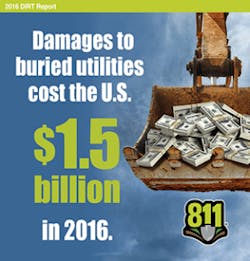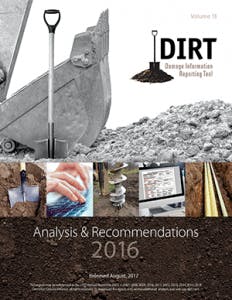Damages to underground facilities conservatively cost society $1.5 billion in 2016 alone, and yet protecting critical infrastructure isn’t always top-of-mind for ICT executives. But because protecting buried infrastructure saves lives, time and money, the Common Ground Alliance (CGA) and its 1,700 members are working to make sure that each and every stakeholder impacted by this important issue shares in the responsibility of safeguarding our nation’s underground facilities.
We’ve come a long way in reducing damages over the last 30 years, and in the last decade since the national 811 call-before-you-dig number was designated by the US Federal Communications Commission in particular. Our best resource for measuring the damage prevention industry’s progress is CGA’s annual Damage Information Reporting Tool (DIRT) Report. Each year, the DIRT Report collects and analyzes data submitted anonymously and voluntarily by facility operators, utility locating companies, one call centers, contractors, regulators, and others, on an annual basis, and has been a tremendous resource since the first edition was produced based on 2004 data.
Long-Term Trends
In August, CGA released its most recent DIRT Report, which analyzed the sum of 2016 damage data. In addition to measuring the steep societal cost of damages to buried utilities for the first time, the report noted several other important findings that highlight both the progress we have made in reducing damages over the years, and the areas where we still have significant improvements to make.
The 2016 DIRT Report benefitted from a record-high number of event submissions as well as a record-high Data Quality Index score (a measurement of the completeness of data submissions), yielding the most comprehensive analysis of damages to buried facilities ever compiled. CGA encourages you to not only join our organization if you have not already, but also to submit your damage data to DIRT (www.cga-dirt.com) to continue to help us improve the quantity and quality of our damage database.
The most recent report found that while estimated damages in the US rose 20% from the year prior, construction spending has risen such that the ratio of damages to construction spending has dramatically declined since 2004 (the first year the DIRT Report was issued), and estimated damages have stabilized into the 300,000-400,000 range since 2010 despite increased construction activity in the interim.
The 2016 Report also found that the overall percentage of damages due to someone digging without calling 811 beforehand dropped to a record-low 16%, part of a long-term trend indicating that CGA members’ dedication to promoting the national call-before-you-dig number is having an impact.
2017 CGA Annual meeting during the CGA 811 Excavation Safety Conference & Expo in Orlando, Fla.
Calling 811 before digging is still the easiest and simplest way to reduce the likelihood of causing damage: Those who call 811 an appropriate amount of time before digging have a less than 1% chance of damaging buried infrastructure.
Public Awareness Continues to Increase
We also conduct national awareness research each year to help our organization and its members gauge our success in spreading our important call-before-you-dig safety message. In general, as public awareness of the free 811 service increases, damages have decreased. Our 2017 awareness research revealed that 45% of Americans have a general knowledge about call-before-you-dig services, while awareness of 811 specifically continues to gradually increase with 39% aided awareness and 9% unaided awareness.
Although CGA does not have an advertising budget, we provide customizable media and advertising materials that our incredibly active and engaged members use to remind the public to always call 811 before digging — and our 2017 awareness survey reveals that this strategy is working well. More than a third of respondents (36%) have seen or heard advertising promoting the 811 service, and of those, 75% are likely to be aware of the need to call before digging. Awareness of 811 advertising drives engagement with the service itself. Respondents who are planning a digging project are very likely to call 811 in the future (8%), and those who have done digging projects in the past are also very likely to call 811 (79%) in the future.
As an organization, we were born out of a foundational study commissioned by the US Department of Transportation called the Common Ground Study, which established the stakeholder engagement model that we continue to use today, and which also spurred the creation of our first Best Practices. Now in its 14th edition, the Best Practices have been regarded and utilized as the preeminent and trusted resource for underground damage prevention since its first edition, released in 2001.
As technologies and infrastructure evolves, our members continually update and tweak the Best Practices to reflect the current environment so that our recommendations are always up-to-date. CGA releases a new edition of the Best Practices each spring, which can be ordered on our website. Additionally, the current Best Practices can always be viewed in its entirety on commongroundalliance.com.
It’s a Shared Responsibility
In addition to our consensus-based model, CGA is a stakeholder-run organization that functions on the principle of shared responsibility: Every stakeholder that owns, maintains, or digs near buried infrastructure has an obligation to participate in the protection of underground facilities.
If your organization is not already a member of the Common Ground Alliance, we urge you to join 1,700 of your peers in doing so. If you’re already a member, please consider deepening your commitment to damage prevention by becoming a sponsor.
[toggle title=”Collaboration Counts” load=”hide”]In striving to reach a goal of zero damages, we encourage you to join a panel of telecommunication experts at the Fiber Optic Asset Protection Summit in Phoenix, Arizona, as part of the CGA 811 Excavation Safety Conference & Expo March 6-8, 2018, where the Common Ground Alliance holds its annual meeting. Issues and concerns facing the fiber optic industry will be addressed, while learning how panel members have participated in successful asset protection programs to improve excavation safety will be discussed.
Together we can be the solution and protect our nation’s connection. Asset protection can be accomplished only if we work together and strive to be better than we were yesterday. For more information, please visit www.CGAconference.com.[/toggle]
Source
Statistics in this article can be found in CGA’s annual DIRT Report.
About the Author






